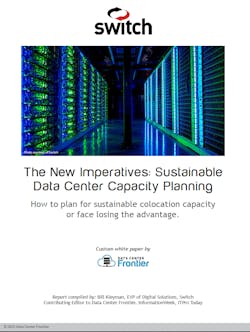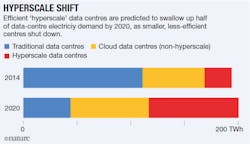Legacy and Inefficiency: Is This Goodbye for the Enterprise Data Center?
Last week we launched our article series on the new imperatives driving sustainable data center capacity planning. This week we'll look at legacy data centers.
A tight focus on sustainability and working with new power solutions has placed the traditional enterprise data center into the industry’s crosshairs. For years, enterprise and legacy data centers would continue to operate without much focus on management or sustainability. Yes, the systems worked, and yes, there was relative uptime. However, many enterprise data centers continued to operate with legacy gear, less density, and a PUE metric going in the wrong direction.
Change is the current constant in the data center landscape.
It’s essential to take a reflective look at the enterprise data center to understand how legacy solutions might impact the overall approach to new digital trends.
And so, we approach our second imperative. This one revolves around legacy infrastructure and the challenges of being sustainable and efficient, and how to plan for the proper capacity levels, so you don’t lose business momentum.
It’s time to ask some reflective questions. How old are the systems running the most critical parts of the company? Has there been a refresh recently? Research from ABB indicates that just 29% of data center decision-makers say their current facilities are meeting their needs, and only 6% say their data centers are updated ahead of their needs. Security (45%) and bandwidth (43%) are the most needed upgrades.
Growth around digital demand has forced enterprise leaders to ask some very fundamental questions, including:
- Do I want to be in the data center business?
- How much time and effort does it take my team to manage our data center reactively?
- What are the real-world benefits of shutting down our data center and moving to a colocation partner?
The truth is that many enterprises are on this journey today. Gartner predicts that by 2025, 80% of enterprises will shut down their traditional data centers. Why is this shift happening? Simple. Enterprises with older data centers don’t want to rebuild or build new ones due to high capital costs.
Colocation, telecommunication services, and emerging sustainability trends are reasons the enterprise data center is experiencing the Hyperscale Shift.
To better focus on their core business, enterprise leaders would rather have someone else manage the physical infrastructure.
To create a more agile and sustainable business, colocation partners are often used to replace legacy enterprise data centers. Hyperscale and colocation partners offer higher availability, vastly improved reliability and scalability, certified building tier levels, unparalleled density, energy efficiency levels, and, very importantly, trained and dedicated facilities management teams.
Understanding how much has changed over the past few years is essential. Colocation, telecommunication services, and emerging sustainability trends are reasons the enterprise data center is experiencing the Hyperscale Shift. Let’s explore our second imperative and understand how the hyperscale shift directly impacts legacy infrastructure.
The Hyperscale Shift
Emerging requirements around applications, data agility, latency, and a very distributed user base must complement edge data centers, modular designs, faster deployments, and more intelligent infrastructure.
As an industry, we are actively amid this shift as enterprise leaders aim to improve operations, better their sustainability standing, and ensure that they develop healthier business and technology standards.
Remember, going green isn’t only good for the environment. It’s also great for business. For example, numerous studies have shown that you can earn more money and boost your bottom line by making your business more sustainable. Reduced business costs, more innovative strategies, an improved reputation, and more new customers who value sustainability all work to increase the value that sustainable businesses earn more money and boost your bottom line by making your business more sustainable. Reduced business costs, more innovative strategies, an improved reputation, and more new customers who value sustainability all work to increase the value that sustainable businesses earn.
Here’s the challenge with the sustainability conversation and a deeper look into the second data center imperative we’ve been discussing: How do you ultimately choose a partner that can support your sustainability efforts? More specifically, if you’re an enterprise-ready to remove the legacy infrastructure weighing you and your business down, what are the critical checklist items to look for when selecting a colocation partner to support sustainability efforts?
It’s time to explore our final and arguably the most critical business and technology imperative: selecting the right partners to ensure sustainable design, proper capacity planning, and an improved speed-to-market strategy.
Download the entire special report, The New Imperatives: Sustainable Data Center Capacity Planning, featuring Switch. to learn more. In our next article, we'll outline the first evaluation criteria on the sustainable data center checklist. Catch up on the previous article here.
About the Author





